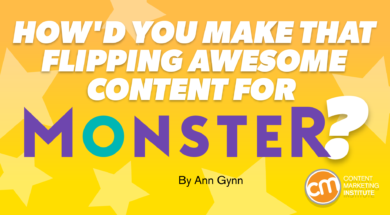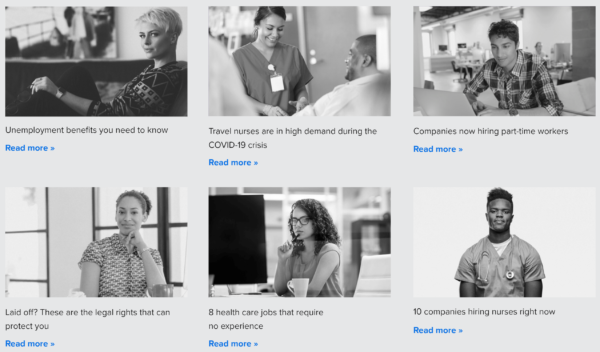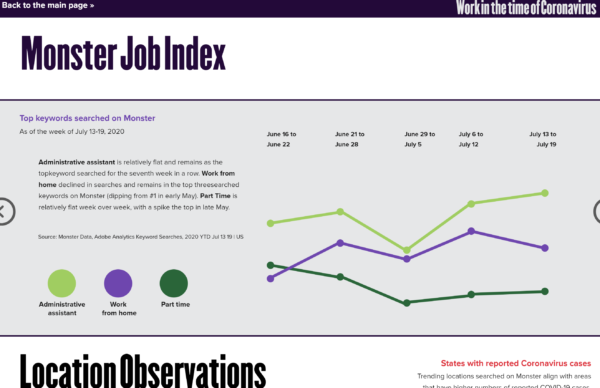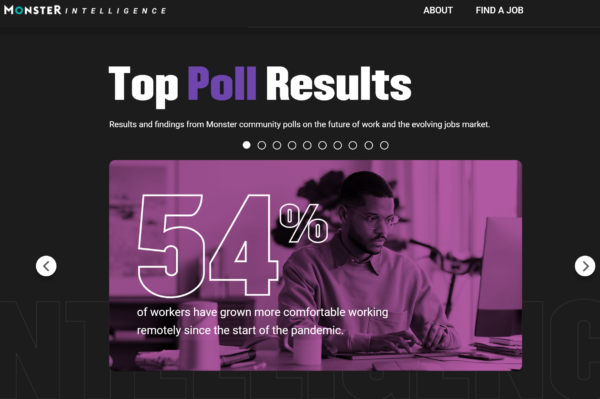 One month after the pandemic hit hard, a new microsite from Monster Worldwide went live: Work in the Time of Coronavirus.
One month after the pandemic hit hard, a new microsite from Monster Worldwide went live: Work in the Time of Coronavirus.
“We went into lockdown in mid-March (2020), and we had launched this in a month,” says Monster’s Carl Germann, senior marketing manager, brand communications. “We couldn’t even believe we did it, you know? We were like, “Wow, this is kind of astounding.”
A month after the world went into lockdown, @Monster launched a new site for workers and employers: Work in the Time of Coronavirus, says @AnnGynn via @CMIContent. Click To Tweet
Julia Gaynor, senior marketing strategist, B2B, agrees: “It was just so rewarding – being able to create so much content that we knew was definitely helping both our customers (companies posting jobs) and our candidates. It felt very meaningful.”
The judges at the Content Marketing Awards 2021 thought so too. It was the winner for the best content marketing launch and led to Content Marketer of the Year finalist honors for Carl and Julia.
But it wasn’t just the expedited timing to create, execute, and publish the site that led to the recognition. The project tackled a number of challenges and made some new discoveries. Work in The Time of Coronavirus effectively addressed multiple audiences and was expanded and adjusted as the marketers learned more about what those audiences were needing. It brought together the Monster teams in new ways, too, from research to sales.
Creating for multiple audiences
“At first glance, we were like, ‘Oh, this is going to be really popular with job seekers. And it turned out to be a little bit more popular with employers. We were really happy with that because we were serving our clients in a way that we weren’t six months prior,” Carl says.
Julia agrees Monster’s new content was even more helpful to employers, particularly in the health care industry. Monster opted to offer free job postings to all health care companies and eventually opened it to all companies seeking essential workers for a time.
This snippet of the site illustrates the relevant topics covered, from what people need to know about unemployment benefits and legal rights around layoffs to health care jobs that don’t require experience and companies hiring nurses right now.

Develop content from your proprietary data
The content included a mix of existing and newly commissioned content with a special ingredient – proprietary Monster data.
@Monster found its proprietary data was a golden opportunity to package into a Monster Job Index and more for workers, employers, and media, says @AnnGynn via @CMIContent. Click To TweetThe site’s data and insights section offered a weekly snapshot of the hiring landscape. It featured results from weekly polls of Monster members and proprietary job-market data, including top searched keywords, top posted jobs, and cities with hiring surges.
They scraped data from the job-seeking candidates as well as the job openings posted by companies. (Monster only uses candidate data in general terms, such as the number of resumes being uploaded, top occupational categories, etc.)
Using that Monster research, they created a new Monster Job Index, among other assets. In this example, they shared the top keyword searches – administrative assistant, work from home, and part-time – and how they had been trending each week in the past month:

As the world got used to the “new normal,” Monster tackled topics like work-from-home burnout, how to pay remote works. They also followed their audience’s growing interest in social inequities with content like how to build a diverse workforce. And they kept up with Monster data and insights.
But they didn’t stop with their two target audiences (companies and job seekers). They published a weekly Monster Job Index and pitched it to top-tier and trade media. Its early success with all three audiences has led them to launch a separate site, Monster Intelligence, in 2021 devoted to all things data.

That new intelligence site was an unexpected outcome of the project. The original goal for Work in the Time of the Coronavirus was to build brand awareness and extend Monster thought leadership across three sectors – candidates, employers, and media.
Get positive results
To draw people to the new site, Monster sent emails to the 5 million job seekers and 500,000 employers in its database. They reached out to media, specifically touting the content in the Monster Jobs Index. Organic social campaigns were created for individual articles, and they did targeted promotion for webinars that came out of the site’s content. As the economic recovery dragged on, they shifted to a paid social campaign of individual articles on related trending topics.
It worked.
The Work in the Time of Coronavirus site averaged 2,500 monthly B2C visits. More importantly, they earned a 52% click-through rate as visitors were motivated to consume additional content on the site. The B2B home page had a 40% CTR, with most clicking to see the proprietary Monster Jobs Index.
@Monster’s coronavirus microsite was a success, averaging a 52% CTR from B2C visitors and a 40% CTR from B2B visitors, says @AnnGynn via @CMIContent. Click To TweetThe individual article promotion was a success. COVID-related posts were 51% more efficient than standard content in driving traffic to the site. COVID-related content accounted for 81% of job views, 84% of new accounts, and 83% of application starts from social.
And the impact continued into the fourth quarter of 2020 and the first quarter of 2021. With a 50-50 content mix of standard career advice and COVID-related articles, the COVID content accounted for 71% of site visits.
As for media coverage, the Monster Jobs Index was responsible for 55% of the company’s media coverage in 2020, and its thought leadership led to a 175% increase in the inclusion of a Monster spokesperson in media coverage.
Unite the organization
But that’s not where the Monster story ends. It’s really just the beginning of a new era – an integrated content approach across the organization.
About two years ago, the small content team at Monster underwent some changes. Carl led more of the company’s PR brand communications efforts, while Julia drove Monster’s B2B content marketing team. But the pandemic’s onset led them to work together on a cohesive content strategy to respond to that incredible moment.
“We could never stop doing it that way. It’s like second nature for us now,” Carl says.
Using Sprout Social’s Bambu tool, they can easily share content with employees who then can share it externally. “We’ve had great success in leveraging that for our sales team,” Carl says. “They needed to keep in contact with their clients. They needed to stay relevant.
“We just kept giving them content and data points (through Bambu) that they could put on their own LinkedIn (or Twitter),” he says.
Today, the marketers deliver new content two to three times a week so that the sales team and others can continue sharing relevant content digitally.
That’s not all. The internal comms team sends out an email blast every Tuesday from the marketing department talking about the latest pieces of content to check out, public relations hits to share, etc. “It’s all become such an integrated aspect of the way we work here,” Carl notes.
All this work hasn’t gone unnoticed by the C-suite either. As Carl explains: “It’s becoming much more apparent to the executive leadership that this is just part of how we do it.”
HANDPICKED RELATED CONTENT:
Are you working on rock star content marketing? Plan to enter the 2022 Content Marketing Awards. Sign up here to be notified when entries are being accepted.
Cover image by Joseph Kalinowski/Content Marketing Institute

